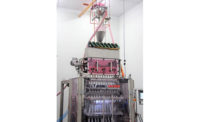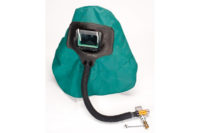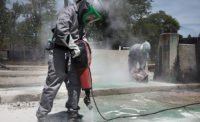Scarring Exposures: Engineering controls capture silica dust particles

Crystalline silica is one of the most common minerals found worldwide in the earth’s crust. It is frequently used in many industrial processes such as mining, quarrying and stone-cutting. Breathing air contaminated with crystalline silica particles can cause serious respiratory and lung diseases. When workers cut, grind or drill materials that contain crystalline silica, they are exposed to small airborne silica dust particles. These processes create a freshly fractured silica dust with sharp edges that create a serious problem.
Silica dust particles from .01 to 100 μm in diameter and 10 microns or less in length are a significant health concern. To put this particle size into perspective, a human hair is about 100 μm in diameter. These small particles can remain suspended in the air for long periods of time, and they cannot be seen with the naked eye in most cases. When inhaled, the small particles penetrate deep into the lungs and can cause scarring, a disease known as silicosis. Even after a person is no longer exposed to silica, silicosis can continue to scar the lungs for many years.
A preventable disease
If your processes generate a respirable silica dust hazard, you need to determine how to protect your workers from exposure in compliance with MSHA and OSHA’s respirable crystalline silica standard for general industry (29 CFR 1910.1053). There is no cure for silicosis, but it is preventable.
The first line of defense is to implement engineering controls – sealing, containing and capturing the dust with a high-efficiency collection system. A cartridge dust collector that captures the contaminant at its source is the most effective control for dust emissions from any manufacturing process, whether the dust is hazardous like silica or just a nuisance.
Next, it is important to implement administrative controls to reduce the amount of time an employee can be exposed to dust in an area. In addition, one of the most important steps is to enforce the use of personal protective equipment (PPE). It is imperative for workers to wear a respirator in areas that are high in silica dust. The respirator should be fit-tested for each employee to assure a good seal to the face.
To determine if your facility is at risk, review the Safety Data Sheets for the materials you are using. A standard SDS lists hazardous ingredients in Section 2. The dust might be identified as crystalline silica, silicon dioxide, quartz, cristobalite or tridymite. The percentage of silica in the product will determine the OSHA exposure limit that you need to maintain.
Control the hazard at the source
A highly engineered cartridge dust collector is a proven engineering control that keeps workers safe and facilities in compliance with this standard. Using a dry media dust collector with high-efficiency cartridge filters and HEPA secondary filters can control hazardous dusts that have PEL limits of 5 micrograms – ten times lower than the 50-microgram OSHA PEL limit.
The most effective control for process dust emissions is using some form of hood or enclosure at the source. With source capture, dust is collected at the point of generation, so it never has the chance to become airborne into the facility. Negative air pressure is maintained on the enclosures to help ensure containment of the dust. Ambient air cleaning systems, by contrast, exchange all of the air in the building or a section of the building. Ambient systems work much like HVAC filtration where all the air in the room is cleaned from remote pick-up points.
Testing your dust
Best practice dictates that your dust collector should be specifically designed for your facility according to your application, type of dust generated and other environmental factors. When considering a dust collector as an engineering control specifically for crystalline silica dust, it is important to have the dust samples tested in a lab to identify particle size, shape and moisture content. This will help to ensure that you design the most effective silica dust collection solution for your facility.
Dust particle size: The efficiency of a dust collector's filter media is based on dust particle size and distribution. For particles larger than 1.0 micron, a standard cellulose-polyester blend cartridge filtration media can be effective. However, if very fine submicron particles are present, you will want to use a high-efficiency nano fiber media to reduce emissions. When nano fibers are applied on top of the base filter media, they form a coating that promotes surface loading of fine dust and keeps it from deeply penetrating into the base media.
Dust particle shape: Silica dust particles have sharp, jagged edges, which makes them very abrasive. If a dust collector is not designed with maximum abrasion resistance, the filter media will develop holes and leak harmful dust into the workplace. To prevent abrasive particles from entering the system at high velocity, look for a dust collector with air inlet that will slow and uniformly distribute the airflow.
Air moisture: When silica dust absorbs moisture from the air, it takes on a mud-like consistency. In this form it is much more difficult to collect, and it gets packed in the filter pleats or cakes into the fabric material. This is a problem if your operation uses water for cooling, lubricating or aiding a process. In these cases, a dry filter may not work, and you will need to consider different media.
References
- Occupational Exposure to Respirable Crystalline Silica, OSHA 29 C.F.R. § 1910.1053, https://www.osha.gov/dsg/topics/silicacrystalline/generalindustry_info_silica.html
- Fact Sheet: OSHA’s Respirable Crystalline Silica Standard for General Industry and Maritime, https://www.osha.gov/Publications/OSHA3682.pdf
Looking for a reprint of this article?
From high-res PDFs to custom plaques, order your copy today!






